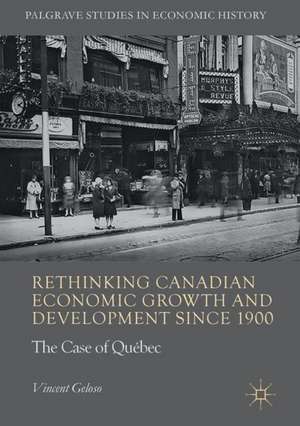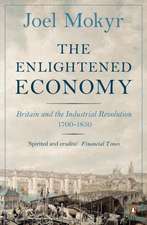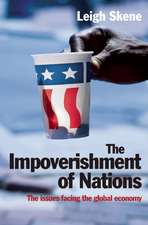Rethinking Canadian Economic Growth and Development since 1900: The Quebec Case: Palgrave Studies in Economic History
Autor Vincent Gelosoen Limba Engleză Hardback – 29 mar 2017
This book upturns many established ideas regarding the economic and social history of Quebec, the Canadian province that is home to the majority of its French population. It places the case of Quebec into the wider question of convergence in economic history and whether proactive governments delay or halt convergence.
The period from 1945 to 1960, infamously labelled the Great Gloom (Grande Noirceur), was in fact a breaking point where the previous decades of relative decline were overturned – Geloso argues that this era should be considered the Great Convergence (Grand Rattrapage). In opposition, the Quiet Revolution that followed after 1960 did not accelerate these trends. In fact, there are signs of slowing down and relative decline that appearafter the 1970s. The author posits that the Quiet Revolution sowed the seeds for a growth slowdown by crowding-out social capital and inciting rent-seeking behaviour on the part of interest groups.
| Toate formatele și edițiile | Preț | Express |
|---|---|---|
| Paperback (1) | 635.65 lei 43-57 zile | |
| Springer International Publishing – 8 mai 2018 | 635.65 lei 43-57 zile | |
| Hardback (1) | 640.88 lei 43-57 zile | |
| Springer International Publishing – 29 mar 2017 | 640.88 lei 43-57 zile |
Din seria Palgrave Studies in Economic History
-
 Preț: 497.34 lei
Preț: 497.34 lei -
 Preț: 358.22 lei
Preț: 358.22 lei - 15%
 Preț: 580.36 lei
Preț: 580.36 lei - 20%
 Preț: 939.29 lei
Preț: 939.29 lei -
 Preț: 292.28 lei
Preț: 292.28 lei - 17%
 Preț: 361.80 lei
Preț: 361.80 lei -
 Preț: 357.89 lei
Preț: 357.89 lei - 20%
 Preț: 690.48 lei
Preț: 690.48 lei - 17%
 Preț: 361.39 lei
Preț: 361.39 lei - 18%
 Preț: 945.79 lei
Preț: 945.79 lei - 18%
 Preț: 1012.53 lei
Preț: 1012.53 lei - 15%
 Preț: 700.29 lei
Preț: 700.29 lei - 18%
 Preț: 782.42 lei
Preț: 782.42 lei -
 Preț: 232.82 lei
Preț: 232.82 lei - 15%
 Preț: 644.82 lei
Preț: 644.82 lei -
 Preț: 384.31 lei
Preț: 384.31 lei - 15%
 Preț: 587.85 lei
Preț: 587.85 lei - 18%
 Preț: 899.21 lei
Preț: 899.21 lei - 18%
 Preț: 786.66 lei
Preț: 786.66 lei -
 Preț: 397.97 lei
Preț: 397.97 lei -
 Preț: 388.90 lei
Preț: 388.90 lei - 18%
 Preț: 737.57 lei
Preț: 737.57 lei -
 Preț: 387.20 lei
Preț: 387.20 lei - 15%
 Preț: 647.73 lei
Preț: 647.73 lei - 15%
 Preț: 646.62 lei
Preț: 646.62 lei -
 Preț: 419.06 lei
Preț: 419.06 lei - 15%
 Preț: 459.06 lei
Preț: 459.06 lei - 15%
 Preț: 712.22 lei
Preț: 712.22 lei - 18%
 Preț: 787.47 lei
Preț: 787.47 lei - 18%
 Preț: 1128.57 lei
Preț: 1128.57 lei - 18%
 Preț: 949.55 lei
Preț: 949.55 lei - 15%
 Preț: 471.53 lei
Preț: 471.53 lei - 18%
 Preț: 898.26 lei
Preț: 898.26 lei - 18%
 Preț: 1394.21 lei
Preț: 1394.21 lei -
 Preț: 422.90 lei
Preț: 422.90 lei - 18%
 Preț: 955.40 lei
Preț: 955.40 lei - 18%
 Preț: 730.47 lei
Preț: 730.47 lei - 15%
 Preț: 711.56 lei
Preț: 711.56 lei - 18%
 Preț: 783.98 lei
Preț: 783.98 lei - 18%
 Preț: 900.01 lei
Preț: 900.01 lei - 18%
 Preț: 896.08 lei
Preț: 896.08 lei - 15%
 Preț: 705.83 lei
Preț: 705.83 lei - 18%
 Preț: 787.15 lei
Preț: 787.15 lei - 15%
 Preț: 704.69 lei
Preț: 704.69 lei - 18%
 Preț: 1112.48 lei
Preț: 1112.48 lei
Preț: 640.88 lei
Preț vechi: 753.97 lei
-15% Nou
Puncte Express: 961
Preț estimativ în valută:
122.67€ • 133.29$ • 103.11£
122.67€ • 133.29$ • 103.11£
Carte tipărită la comandă
Livrare economică 21 aprilie-05 mai
Preluare comenzi: 021 569.72.76
Specificații
ISBN-13: 9783319499499
ISBN-10: 3319499491
Pagini: 172
Ilustrații: XXI, 212 p. 64 illus.
Dimensiuni: 148 x 210 x 14 mm
Greutate: 0.43 kg
Ediția:1st ed. 2017
Editura: Springer International Publishing
Colecția Palgrave Macmillan
Seria Palgrave Studies in Economic History
Locul publicării:Cham, Switzerland
ISBN-10: 3319499491
Pagini: 172
Ilustrații: XXI, 212 p. 64 illus.
Dimensiuni: 148 x 210 x 14 mm
Greutate: 0.43 kg
Ediția:1st ed. 2017
Editura: Springer International Publishing
Colecția Palgrave Macmillan
Seria Palgrave Studies in Economic History
Locul publicării:Cham, Switzerland
Cuprins
Chapter 1. Introduction.- Chapter 2. Québec’s economic development from 1900 to 1939.- Chapter 3. The Great Catch-Up of 1945-1960: Economic conditions.- Chapter 4. The Great Catch-Up of 1945-1960: Health and Education.- Chapter 5. The Great Catch-Up of 1945-1960: Quebeckers’ social behaviour and the Church.- Chapter 6. Explaining the Great Stagnation.- Chapter 7. Explaining the transition to the Great Catch-up.- Chapter 8. The Quiet Decline (1960–today): Economic conditions.- Chapter 9. The Quiet Decline (1960–today): Education.- Chapter 10. Explaining the Quiet Decline.- Chapter 11. Conclusion.
Notă biografică
Vincent Geloso is a post-doctoral fellow at Texas Tech University, USA. He earned his PhD at the London School of Economics, UK. His research interests include Economic History and the Economics of Religion, and he has published in Journal of Population Research, Economics Bulletin, Agricultural History Review, Essays in Economic and Business History and Economic Affairs. He is also an economics blogger at the Journal de Montréal, the largest French newspaper in Canada.
Textul de pe ultima copertă
This book upturns many established ideas regarding the economic and social history of Quebec, the Canadian province that is home to the majority of its French population. It places the case of Quebec into the wider question of convergence in economic history and whether proactive governments delay or halt convergence.
The period from 1945 to 1960, infamously labelled the Great Gloom (Grande Noirceur), was in fact a breaking point where the previous decades of relative decline were overturned – Geloso argues that this era should be considered the Great Convergence (Grand Rattrapage). In opposition, the Quiet Revolution that followed after 1960 did not accelerate these trends. In fact, there are signs of slowing down and relative decline that appearafter the 1970s. The author posits that the Quiet Revolution sowed the seeds for a growth slowdown by crowding-out social capital and inciting rent-seeking behaviour on the part of interest groups.
Caracteristici
Argues against the 'Great Darkness' thesis that states Quebec was backwards before 1960 by demonstrating through cliometrics that Quebec actually closed the gap between itself and the rest of Canada (and the United States) between 1945 and 1960 after decades of relative stagnation Provides a counterfactual portrait of the Quiet Revolution Answers the questions: Would present-day Québec really be that different if the State had been less interventionist? Was the notion of the Great Darkness invented to expunge the Quiet Revolution and its concomitant policies of accountability for their negative consequences? Examines policies that led to an awakening of French Canadian entrepreneurship as well as a population-wide shift in thinking about industrialization, economic development, and the business world












